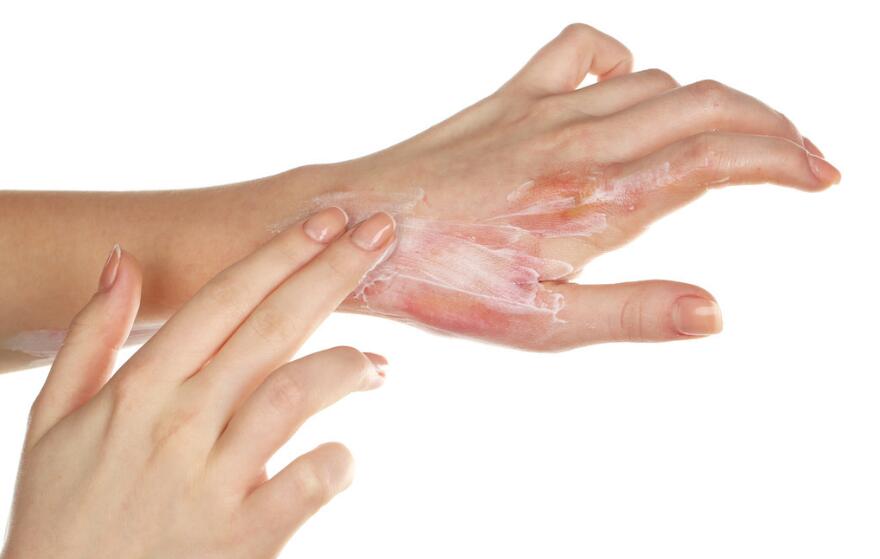
Prevention of hand burn scar contracture
When the burn depth is deep Ⅱ degree and above, scars and scar contractures are often left. Scar contracture is a fibrous disease caused by the disordered proliferation of fibers. It often occurs after burns/traumas that damage the dermis. Clinically, scar contracture deformity is a common complication after hand burn. Investigations by Hop et al. showed that the first major part of reconstructive surgery due to scar contracture within 10 years after burn is the hand. The American Burns Association believes that hand burns are a serious trauma and should receive professional treatment to reduce the sequelae of hypertrophic scars and scar contractures. Scar contracture can cause the normal movement of the hand to be restricted, and long-term scar contracture can easily cause secondary contracture deformities in deep tissues, further aggravating the dysfunction of the limbs.
Hand burns mainly occur on the back of the hand. This is because the back of the hand is often exposed to the outside, increasing the possibility of injury. And because the skin on the back of the hand is thinner than the palm of the hand, scar contracture after a hand burn also mainly occurs on the back of the hand. Scar contracture after hand burn is mainly manifested as metacarpophalangeal joint dorsal extension, interphalangeal joint flexion and finger web deformity. If there is both metacarpophalangeal joint dorsal extension and interphalangeal joint flexion, a claw-shaped hand is formed. Hand contractures may also involve the wrist, which is usually just a skin problem and does not affect wrist function. Severe contractures generally have bone deformities, which can be diagnosed by X-ray film. Hand burns in children are mostly caused by grasping hot solids or immersing the whole hand in hydrothermal fluid, so the common hand deformity is fist-shaped hand.
1. Prevention of hand burn scar contracture
1.1 Early transplantation of large skins and prevention of infection
Early scab cutting and large autologous skin transplantation are the best methods to prevent scar contractures. Both local function and appearance can achieve better results. Especially for patients with extensive burns of the whole body, skin grafts should be performed on both hands 4-7 days after the injury and carried out simultaneously with the first escharectomy and skin grafting on the whole body. The skin grafts are performed simultaneously. If the source of autologous skin is low, you can use autologous thin and medium-thick scalp or use relatives' scalp and autologous thin-medium-thick scalp to make micro-scalp hybrid grafts to repair deep wounds of hands. In addition, reasonable use of antibiotics, strengthening of nutrition, correction of water and electrolyte disorders, maintenance of organ function, disinfection and isolation, and aseptic operation can prevent infection of hand wounds, avoid delayed healing, and reduce scar formation and future scar contracture.
1.2 pressure therapy
The materials used in pressure therapy include pressure gloves, elastic bandages, etc. The most commonly used pressure therapy for hand burn patients is to wear pressure gloves. Pressure gloves should be used for wounds that heal naturally in the 2nd to 3rd weeks after surgery. Pressure gloves can reduce scar formation through pressure and creating a relatively hypoxic environment. Wear pressure gloves for at least 23 hours a day for 6 months to 1 year.
1.3 applied silicone
Within 1 year after a burn, water evaporates rapidly at the scar, which promotes scar hyperplasia. The silicone material can be used for air permeability and impermeability to cover the scar tissue to prevent scar hyperplasia. The best time to apply the silicone gel sheet is 2 weeks after the wound has healed, and the best effect is to be applied in the next six months [8]. Pressure gloves are often used in combination with silicone materials. Their functions are complementary. Pressure gloves prevent scars from thickening, while silicone materials soften scars.
1.4 wear orthosis
In the later stage of hand burn rehabilitation, scar contracture persists, especially in children, growth and development will promote contracture deformity. Wearing orthoses can counteract tissue contractures and correct joint deformities. Adult patients can wear static or dynamic orthoses made of low-temperature thermoplastic panels. Due to the complicated operation of some commercial orthotics, it is difficult for children and parents to accept them. The simple orthosis can be made from materials such as children’s infusion hand fixing plate, self-made finger webbing, self-adhesive elastic bandage, etc. The simple orthosis is designed The production is simple, practical, economical and beautiful, and it is easy for children and parents to accept. However, the orthosis is not suitable for the wounds that are not easy to repair due to chemical burns or severe electric shocks, as well as patients with complicated injuries such as finger flexion adhesions.
1.5 Spa and wax therapy
For the prevention of hand burn scar hyperplasia, the main physical therapy methods are hydrotherapy and wax therapy. Hydrotherapy refers to soaking hand wounds in 40 ℃ warm water once or twice a day for 15 to 20 minutes each time after healing, and with hand exercises, it has the effect of softening scars. Wax therapy can effectively reduce inflammation, improve pain, soften scars, and even speed up wound healing; but it also has the effect of accelerating blood circulation and increasing blood supply to the scar, so there is a risk of aggravating scar hyperplasia.
1.6 sports training
Early and reasonable exercise training can prevent limb dysfunction. As long as the patient's general condition permits, generally around 10 days after injury or after surgery, the patient is encouraged to perform light hand movements, gradually increase the joint range of motion, and assist the thumb and each finger in the palm, finger, finger, and fist exercises. Exercise time is gradually extended, and the amount of exercise gradually increases. The frequency and duration of training are at least 3 times a day, at least 30 minutes each time, and persist for 6 months.



